Bonito Tataki (Seared Bonito) is the representative sashimi dish of Kōchi prefecture. When the bonito skin is seared and charred, it gives an appetising aroma to the sashimi. Slice the fillets thicker than usual sashimi slices and eat them with ponzu dressing.
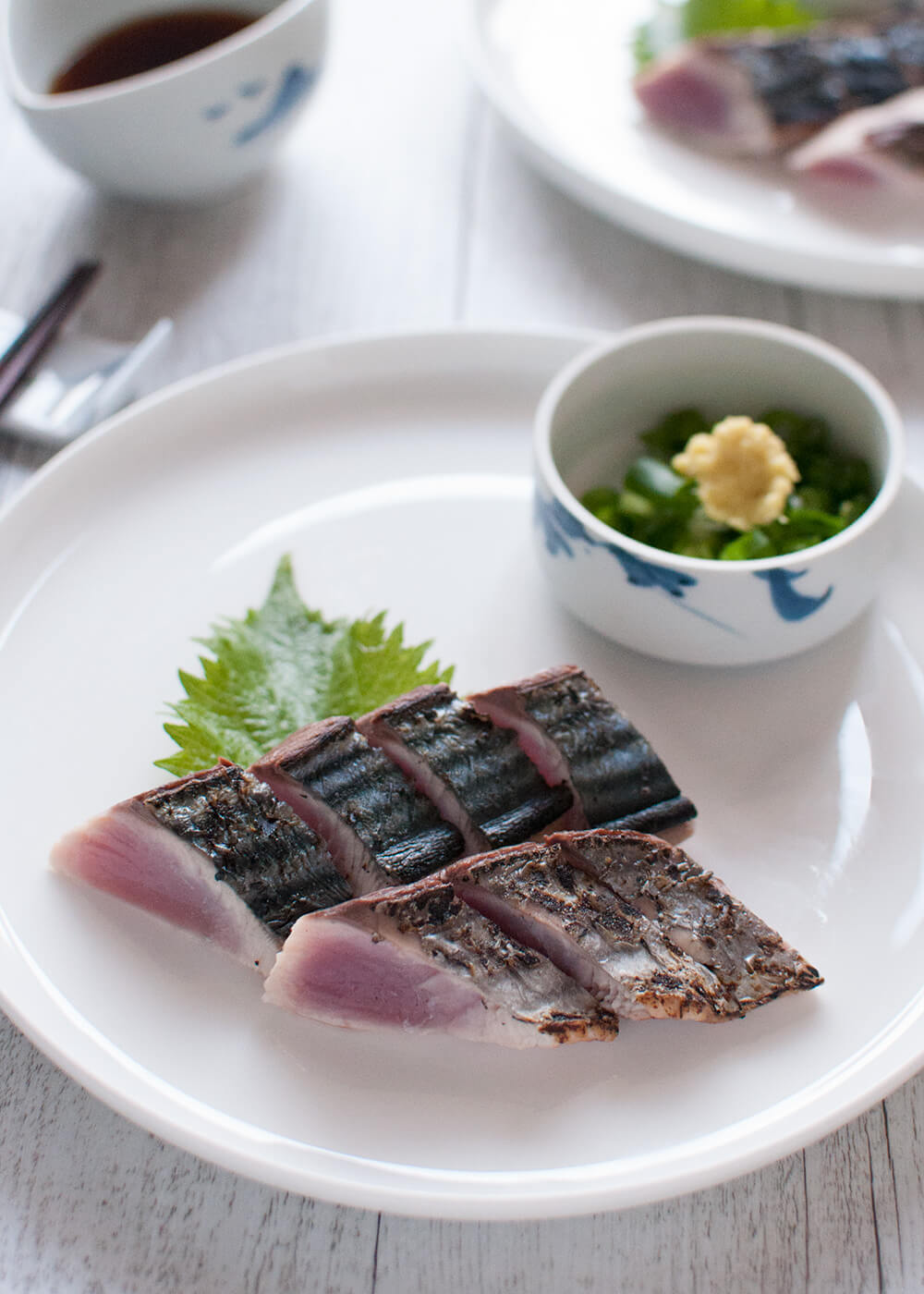
Last week, I posted a different tataki dish, Japanese-Style Kingfish Tartare (Kingfish Tataki) where I touched on this Bonito Tataki. I thought it would be good to introduce two tataki dishes next each other so that you could see the difference between the two despite the fact that they were both called ‘tataki’.
The reason seared fish is called fish tataki is because of the way the original fish tataki was made in the Edo period. It started in Kōchi prefecture, which is famous for bonito fishing.
The bonito is filleted into 4 long portions that are seared around the skin and the surface of the flesh, then sliced like thick sashimi pieces. After that, each piece is placed on a cutting board and hit with the side of a knife or the palm of the hand after sprinkling salt on it, so that the salt infuses into the flesh.
From this hitting act, Seared Bonito is called ‘katsuo no tataki’ (鰹のたたき, pounded bonito). ‘Katsuo’ (鰹) is bonito and ‘tataki’ (たたき) means pounding in Japanese. But these days, if the fillet is seared and served as slices, the dish is called ‘tataki’ even without pounding it.
Katsuo no tataki is now considered to be the local specialty of Kōchi prefecture. Kōchi prefecture is famous for the angling fishing of bonito for commercial supply. When the fish is caught using a fishing rod instead of using nets, the stress level of the fish is much lower and thus, the quality of the fish is better.
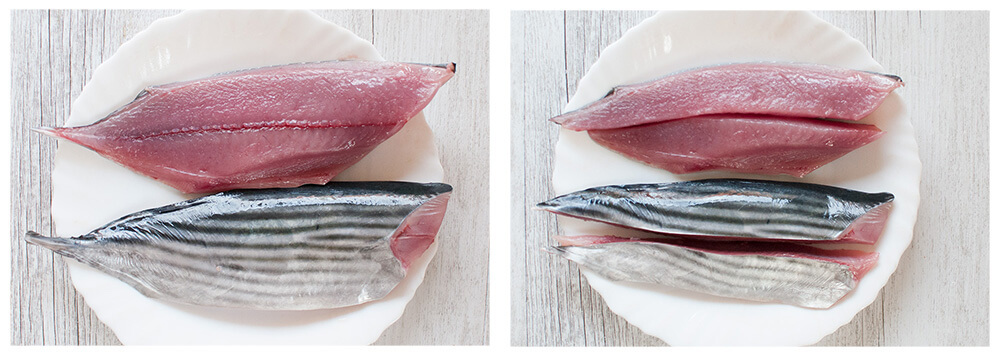
Bonito in Kōchi prefecture is so famous that Japanese people will think of Kōchi when they hear the word ‘katsuo’. So, it is natural for bonito tataki to become the local specialty.
When making bonito tataki, it is important to sear it with the skin on. The skin should be seared all over until it gets charred here and there, but not to blacken the entire skin. Burning the skin serves three purposes – (1) removes the fishy smell, (2) makes the skin tender, not chewy, (3) brings up the appetising aroma.
At good restaurants in Kōchi, they sear the fish over burning straw to bring out the aromatic effects of the straw. This is hard to do at home on the cook top. But if you are making seared bonito outdoors on a camp fire or something, you might be able to do that.
Bonito Tataki vs Bonito Tosazukuri
There are two ways of serving seared bonito. The way to sear bonito fillets is the same in both serving methods. The difference is how you treat the seared fillets before slicing them.
One way is to chill the fillet in icy water immediately after searing it. The other way is not to chill the seared fillet and serve it warm.
The chilled method is probably more common in Japan and my recipe is adapted to this method. And it is generically called Bonito Tataki.
The bonito tataki served warm is the traditional serving method you find in Kōchi prefecture. Since Kōchi prefecture is used to be called ‘Tosa’ (土佐), the bonito tataki served warm has its own name, ‘Katsuo no Tosazukuri’ (鰹の土佐造り, Bonito Tosazukuri) meaning bonito made the Tosa way.
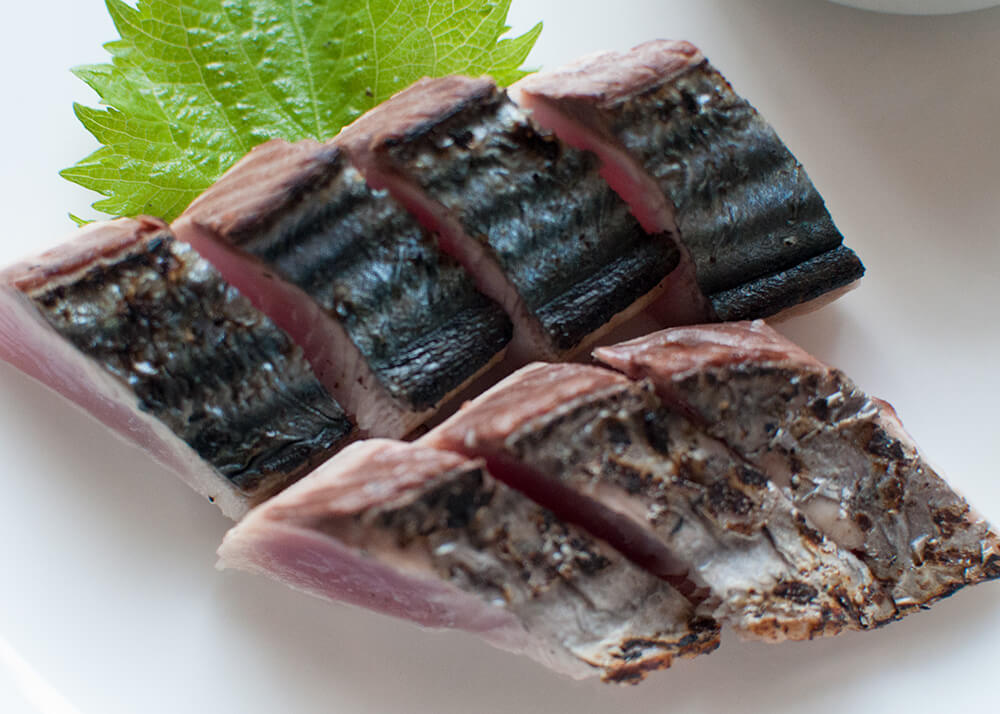 Searing Bonito
Searing Bonito
In my recipe, I seared the bonito fillets over the gas cook top, keeping the flames directly touching the fillet. To do this, I used 4 long metal skewers put through the fillet in a fan shape so that the fillet is stretched flat and you can hold the ends of the skewers in one hand.
It is ideal to use very thin skewers to minimise the size of the holes in the fillet. If you don’t have metal skewers, you can use a griddle over the stove/BBQ or a frying pan to sear the fillet. Do not use bamboo skewers as they will burn.
All you need is to get the skin burnt and the flesh side to change colour to white. If using a frying pan, it might be difficult to get the skin charred without over cooking the fish. So, make sure that the frying pan is very hot before placing the skin side down.
When all sides of the fillet are seared, I put the fillet into the icy cold water to cool it down. You only need to leave it in the water for 15 seconds or so. Do not leave it in the water too long as the sashimi becomes soggy and not tasty. Pat dry the fillet with kitchen paper and cut it into thick slices.
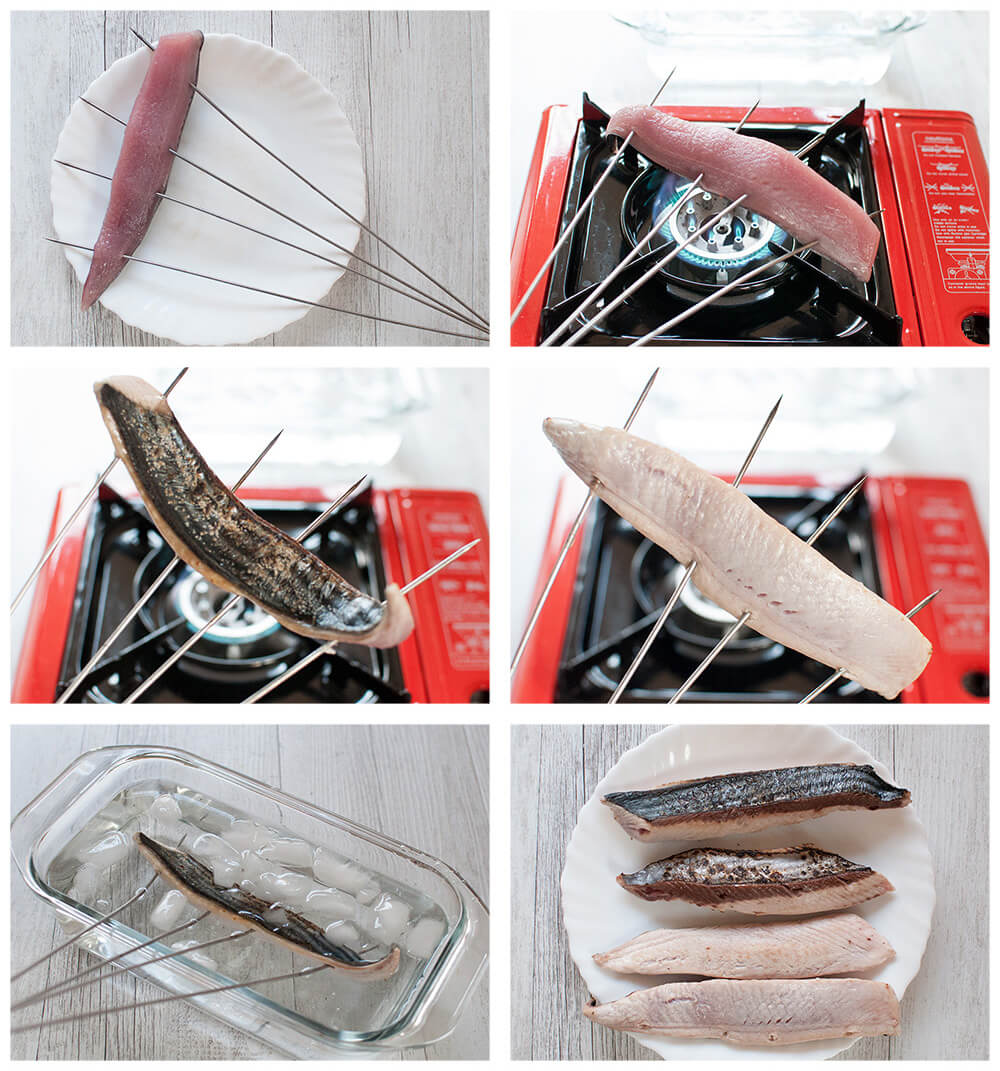 Dipping Sauce and Condiments
Dipping Sauce and Condiments
Bonito tataki is usually served with ponzu dressing (citrus soy sauce) and finely chopped shallots (scallions), grated ginger and/or sliced garlic. But you can simply serve tataki with soy sauce if you want. In my recipe today, I did not use garlic but many people like bonito tataki with a bit of garlic.
You can buy ponzu dressing at Japanese/Asian grocery stores or you can make your own (please visit my post Japanese Dressings for the recipe). Some people just eat it with a bit of salt.
Now I have posted two sashimi dishes in a row. I promise that the next post will not be a fish dish.
Yumiko![]()
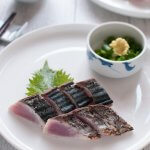
Bonito Tataki is the representative sashimi dish of Kōchi prefecture. When the bonito skin is seared and charred, it gives an appetising aroma to the sashimi. Slice the fillets thicker than usual sashimi slices and eat them with ponzu dressing.
- 2 sides of bonito with skin on , about 360g (0.8lb) in total (note 1)
- 4 thin metal skewers , about 2mm (1/16") diameter 35cm (13¾") long (note 2)
- Salt
- Water with ice in a large bowl/baking pan (note 3)
- Shiso leaves (I used these), shredded lettuce or julienned white radish
- Ponzu dressing (Citrus soy sauce dressing, note 4)
- Finely chopped shallots (scallions)
- Grated ginger and/or thinly sliced garlic
-
Cut each side of bonito along both sides of the spine, as close to the spine as possible (to remove bones along the spine). Discard the spine strips. This will make four long portions.
-
Place the fillet skin side down on a cutting board and stab four skewers through the fillet at equal intervals. Put the skewers through in such a way that they make a fan shape and the base ends of the skewers are bunched together to allow holding of the end easier (see the step-by-step photos).
-
Sprinkle small amount of salt over the skin.
-
Turn the stove on high. Holding the base of the skewers, sear the skin side of the fillet, starting from one end of the fillet and moving slowly to the other end.
-
Make sure that the entire skin is seared and slightly burnt with some charred spots.
-
Turn the fillet over and sear the flesh. You will only need to sear to make the colour of the surface to whitish.
-
Place the fillet in the ice water for 15 seconds or so to cool it down quickly, then use kitchen paper to dry it. Place it on a plate.
-
Repeat for the remaining fillets.
-
Place a seared fillet on a cutting board, skin side up. Slice the fillet into pieces about 1 cm thick and plate them into a group of 3-4 slices with garnish (see the photos in the post).
-
Serve with ponzu dressing and condiments.
1. I bought a whole bonito which was 1.5kg (3.3lb), about 35cm (13¾") long but when filleted, it weighed only 350g (0.8lb) for two sides.
2. If the skewers are slightly thicker, that’s ok but then you might need only 3 skewers. Bamboo skewers are not suitable as they will burn.
If you don’t have skewers, you can sear the fillets on a griddle over the stove/BBQ or a frying pan. Make sure that the griddle/frying pan is very hot so that the bonito skin gets burnt quickly.
3. This is to cool down the seared fillet so you need a bowl/baking dish with the sufficient width to dip the entire fillet in.
4. It is a tradition to eat bonito tataki with ponzu dressing but if you prefer, you can use soy sauce. My post, Japanese Dressings describes how to make ponzu dressing at home. You can also buy a bottle of ponzu dressing at Asian/Japanese grocery stores.
Hello
I really wanna make this dish but I can’t find Bonito anywhere close to my place. Is it any substitute fish for that? Thank you
Hi Vee, you can use tuna or kingfish. You won’t have skin on the meat but you can apply same technique.
Yes, you can substitute a piece of Tuna
Hi Yumiko
Thank you for your wonderful recipes. I lived in Japan for a short while and I love making Japanese food now that we are back in Sydney.
I would like to ask you where you source your Shiso leaves in Sydney please?
Thank you!
Hi Amrita, I buy shiso leaves at Tokyo Mart in Northbridge Plaza, Northbridge. Shiso is a summer vegetable but they still sell it even now. If I remember correctly, fresh leaves are delivered on every Tuesday or Wednesday so if you go there soon after that, you are almost guaranteed to find some. Sunday or Monday might be risky. During summer time, the Japanese grocery store called Anegawa in Artarmon, near the station, also stock shiso leaves. I buy shiso from these shops only because they are closer to my place. There are Japanese grocery stores in other parts of Sydney including city and they might sell it, too. From my experience, only the genuine Japanese grocery stores sell shiso. Other Asian grocery stores might sell shiso leaves but they are most likely a different species and much larger with totally different flavours.